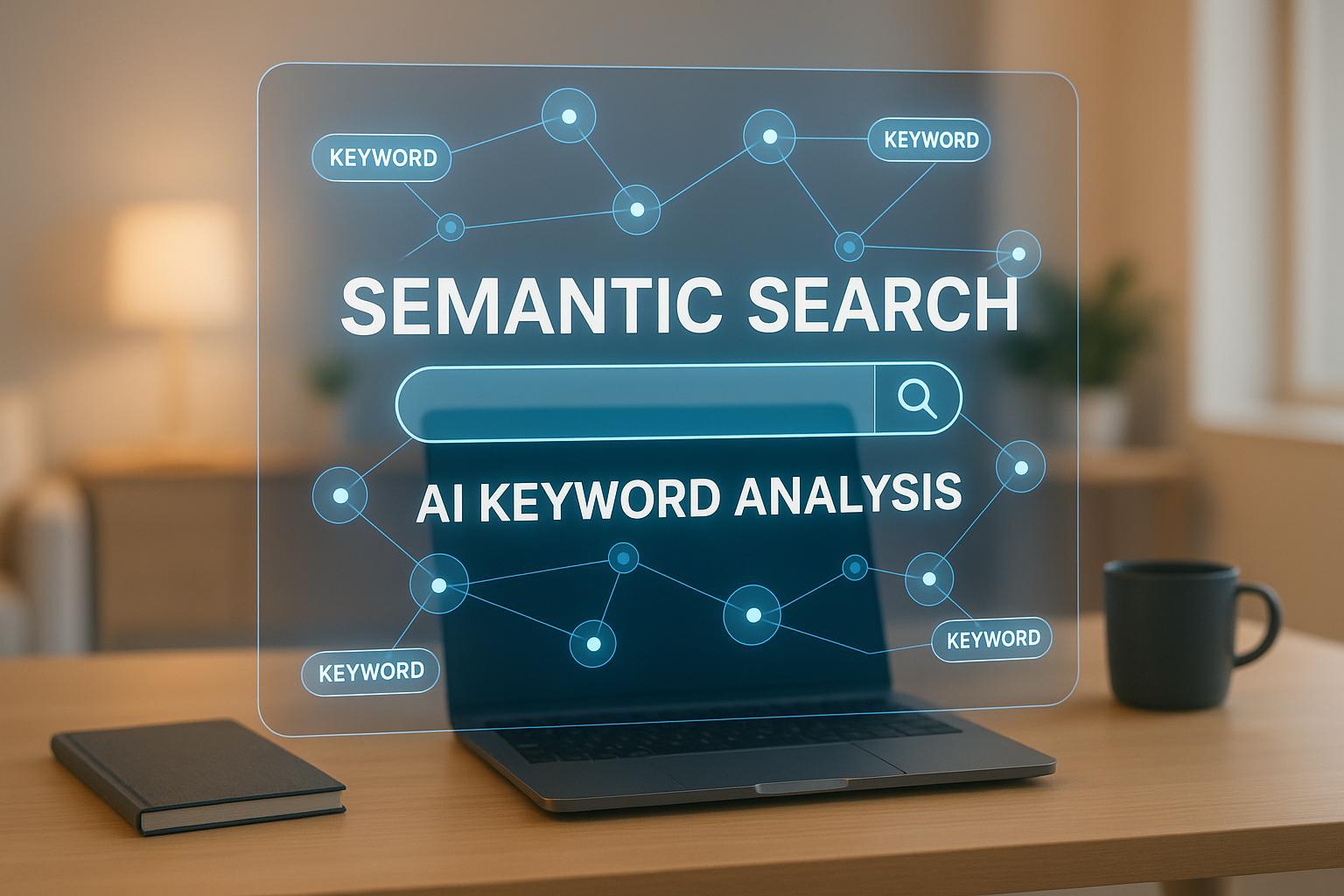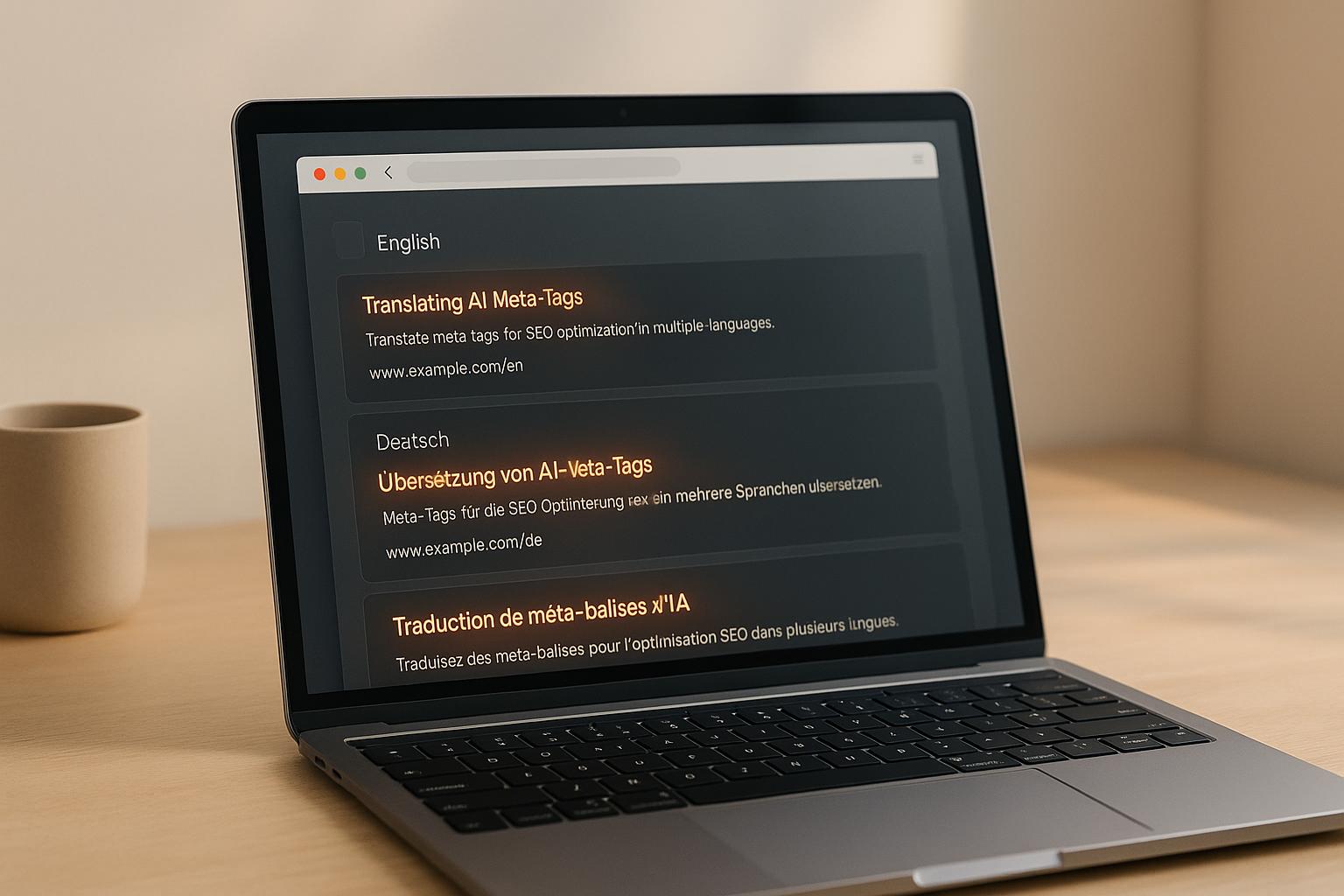

Semantic Search and AI Keyword Analysis

Semantic Search and AI Keyword Analysis
 29-09-2025 (Last modified: 29-09-2025)
29-09-2025 (Last modified: 29-09-2025)
Search engines have evolved. Instead of focusing solely on exact keywords, they now prioritize understanding user intent and context. This shift, driven by semantic search and AI-powered keyword analysis, has transformed SEO and content creation.
Key Takeaways:
- Semantic Search: Focuses on meaning and intent, not just matching words. It uses AI to interpret relationships between terms and user goals.
- AI in Keyword Analysis: Goes beyond traffic numbers by analyzing context, user behavior, and related terms to optimize content strategies.
- Why It Matters: Search engines reward content that answers user questions thoroughly. This leads to better visibility and higher conversions.
Quick Overview:
- Semantic search improves relevance by understanding synonyms, context, and user needs.
- AI tools cluster related keywords, helping create content that covers topics comprehensively.
- Businesses benefit from tools like PageTest.AI to test and refine content based on semantic principles.
This article explains how these technologies work, their impact on SEO, and how businesses can leverage them for better results.
AI-Powered Semantic SEO with Koray Gubur
Core Principles of Semantic Search
To truly grasp semantic search, it’s essential to understand the technologies driving it. These systems rely on advanced AI techniques designed to interpret language in ways that mimic human understanding.
How NLP and Machine Learning Power Semantic Search
At the heart of semantic search lies Natural Language Processing (NLP), which equips computers to comprehend the intricacies of human language. By breaking down text into its grammatical components, NLP enables machines to analyze language structure. Meanwhile, machine learning models take this a step further, learning from massive datasets to identify subtle word relationships and patterns.
A key breakthrough in this field is the development of word embeddings. These mathematical models map words into a multi-dimensional space, grouping similar terms – like “car”, “automobile”, and “vehicle” – closely together. This allows algorithms to recognize related concepts, even when different words are used.
The training process for these systems involves analyzing billions of text sources, from web pages to books. By observing how words frequently appear together in specific contexts, machine learning models develop a deeper understanding of language. This shift from simple keyword matching to nuanced contextual analysis is what enables semantic search to interpret intent rather than just words.
From Keyword Matching to Contextual Understanding
Traditional search engines worked like basic filing systems, matching exact keywords in queries to words on web pages. For example, a search for “apple pie recipe” would return results containing those specific terms in that order.
Semantic search, however, takes a more sophisticated approach by focusing on context. It considers factors like your location, device, search history, and even the time of day to better understand your intent. For instance, searching for “apple” at lunchtime might suggest you’re looking for nutritional information about the fruit, while the same search near an electronics store could point to an interest in Apple products.
A major innovation in this area is entity recognition, which identifies specific people, places, organizations, or concepts within a query. For example, a search for “Michael Jordan basketball” ensures results focus on the legendary athlete, not someone else with the same name.
Context also plays a crucial role in distinguishing between similar phrases. For instance, “bank account” refers to finance, while “river bank” relates to geography. Semantic search algorithms use surrounding context to interpret these differences, delivering results tailored to the user’s actual intent.
This evolution has significantly improved search accuracy. Instead of just returning pages that happen to include your keywords, modern search engines provide content that directly addresses your question or need.
Examples of Semantic Search in Action
The impact of semantic search becomes clear when you examine real-world examples:
- Ambiguous queries: Take a search like “jaguar speed.” Traditional keyword matching might mix results about the animal and the car brand. Semantic search, however, analyzes context – like previous searches or related terms – to determine whether you’re interested in the big cat’s running speed or the sports car’s acceleration.
- Question-based searches: A query like “How do I remove red wine stains from white shirts?” doesn’t rely on exact keyword matches. Instead, semantic search identifies content about stain removal and fabric care, even if the phrasing differs.
- Local intent recognition: Searching for “pizza delivery” automatically factors in your location to show nearby restaurants. There’s no need to include your address because the system understands that delivery queries are inherently location-specific.
- Seasonal and temporal context: Timing also plays a role. A search for “holiday decorations” in December will prioritize Christmas-related content, while the same query in October leans toward Halloween items.
These examples highlight how semantic search goes beyond simple keyword matching, delivering results that align with what users truly need. It’s this deeper understanding of language, context, and intent that makes semantic search so effective.
AI-Driven Keyword Context Analysis for Modern SEO
Modern SEO has embraced AI to transform how we approach keyword strategies. Gone are the days of keyword stuffing; today, AI tools help us understand the intent behind search queries, grouping related terms and uncovering user intent in ways that were unimaginable just a few years ago. This evolution has reshaped keyword research and optimization, making it more precise and user-focused.
Keyword Clustering by Intent and Context
One of AI’s standout capabilities is its ability to organize keywords into meaningful clusters based on search intent and contextual relationships. It recognizes that different phrases often aim to address the same need or question.
AI categorizes keywords into three primary intents:
- Informational: Queries like “how to bake sourdough bread” cluster together as they aim to educate or inform.
- Transactional: Searches such as “buy bread maker” focus on purchasing or taking action.
- Navigational: Phrases like “local bakery near me” are used to locate specific services or destinations.
This clustering method is a game-changer for content strategy. Instead of creating separate pages for each keyword, you can craft a single, in-depth article that covers an entire keyword cluster. For instance, a comprehensive guide on sourdough baking could rank for terms like “sourdough hydration levels” and “artisan bread techniques”, maximizing your reach with one well-optimized piece.
AI also identifies connections between keywords that might not be obvious to human researchers. This insight helps content creators cover a broader range of topics that matter to their audience, ensuring the content is both thorough and engaging.
Clustering doesn’t just streamline content creation – it highlights gaps in your strategy. If competitors are ranking for clusters you’ve overlooked, AI tools will flag these missed opportunities. This ensures you’re not leaving valuable search traffic untapped.
Improving Keyword Research with AI Tools
AI has revolutionized keyword research by uncovering opportunities traditional methods often miss. These tools analyze search patterns, competitor strategies, and user behavior data across millions of queries to generate smarter keyword suggestions.
One of AI’s most powerful features is its ability to surface long-tail keywords and question-based queries that reflect how people search in real life. For example, instead of just targeting “running shoes”, AI tools might reveal searches like “best running shoes for flat feet”, “waterproof running shoes for winter”, or “how to choose running shoes for beginners.” These detailed queries often attract users with specific needs, leading to higher conversion rates.
AI also tracks search volume trends and seasonal patterns, helping you prioritize keywords based on when they’re most relevant. For instance, fitness-related terms usually spike in January, while tax-related searches dominate from February to April. Timing your content around these trends can significantly boost visibility.
Another major advantage is competitive gap analysis. AI tools compare your keyword portfolio with your competitors’, identifying terms where they’re ranking and you’re not. This insight allows you to spot new opportunities and refine your strategy to stay competitive.
While AI delivers an impressive range of keyword suggestions, human insight remains essential. It’s crucial to review AI-generated recommendations through the lens of your brand’s voice, audience preferences, and business goals. This ensures that your content not only ranks well but also aligns with your overall strategy.
The best results come from blending AI’s analytical power with human expertise. Use AI to build comprehensive keyword lists and identify clusters, then apply your knowledge to prioritize and refine the data. This hybrid approach keeps you in control while leveraging the efficiency of AI.
Finally, AI tools can optimize your existing content by pinpointing semantic gaps – terms or concepts your pages might be missing. By incorporating these suggestions, you can boost your content’s topical relevance and authority, ensuring it remains competitive as search algorithms evolve. This continuous refinement process strengthens your content’s visibility and improves conversion rates, making AI an indispensable part of modern SEO strategies.
sbb-itb-6e49fcd
Semantic Search vs. Traditional Keyword Search
Semantic search and traditional keyword search operate on fundamentally different principles, each excelling in specific SEO scenarios. Knowing when to use each approach can help you tailor your content strategy to meet varying user needs.
Traditional keyword search focuses on exact matches and string matching. For example, if someone searches for “running shoes”, the system retrieves pages containing those exact words. While straightforward, this method can miss relevant results that use alternative phrasing or synonyms.
Semantic search, on the other hand, analyzes context, synonyms, and user intent to provide more nuanced results. It understands that terms like “athletic footwear”, “jogging sneakers”, and “running shoes” all refer to the same thing. By interpreting the meaning behind the query, semantic search delivers results that align with what the user is actually looking for, not just what they typed.
Key Features and Use Cases Comparison
| Aspect | Traditional Keyword Search | Semantic Search |
|---|---|---|
| Matching Method | Exact keyword matching | Context and meaning understanding |
| Query Processing | String analysis | Natural language processing |
| Result Precision | High for exact matches | High for intent-based queries |
| Vocabulary Flexibility | Limited to exact terms | Handles synonyms and variations |
| Speed | Fast processing | Slightly slower due to analysis |
| Best Use Cases | Product codes, technical terms | Conversational queries, research questions |
| Content Requirements | Keyword-optimized text | Context-rich, topically relevant content |
| User Experience | Requires precise query formulation | Natural, conversational search style |
When to Use Each Approach
The choice between traditional and semantic search often depends on the user’s intent and the type of content being searched.
Traditional keyword search works best in scenarios where precision is critical. For instance:
- E-commerce searches: Users looking for specific products, such as “iPhone 15 Pro Max 256GB” or “Adobe Photoshop CC 2024.”
- Technical documentation: Queries involving exact error codes, feature names, or procedural steps.
- Legal and medical databases: Searches requiring precise terminology, such as specific regulations, case law, or medical conditions.
On the flip side, semantic search shines in situations where users are exploring or seeking broader insights:
- Content websites and blogs: Users often ask open-ended questions like “best smartphone for photography under $800” or “how to improve website conversion rates.”
- Customer support systems: Semantic search helps interpret natural language queries like “Why won’t my account sync?” and connects them to relevant troubleshooting resources, even if the phrasing differs.
A Hybrid Approach
Many successful websites now combine both methods to maximize their strengths. For example:
- Traditional keyword search can handle navigational queries and product searches.
- Semantic search can enhance content discovery and address conversational queries.
Optimizing Content with AI-Powered Tools
AI is reshaping how we approach content optimization. These advanced tools empower marketers and website owners to test and improve their content systematically, using semantic analysis and data-driven insights to guide decisions.
One of the biggest challenges in content optimization is understanding how different elements – like headlines, CTAs, and product descriptions – perform across various audience segments. AI tools tackle this by suggesting alternative versions of content that are more likely to resonate with users. This marks a major shift toward a more structured and efficient approach to content testing.
How AI Tools Simplify Content Testing
AI-powered platforms have made content testing more accessible than ever by eliminating technical hurdles. A great example is PageTest.AI, a no-code solution that allows users to test and optimize website elements without needing advanced technical skills. It builds on the principles of semantic search by testing how different variations of content perform in real-world scenarios.
Using the platform’s Chrome extension, users can select any element on their website – whether it’s a headline, a CTA button, or a product description – and effortlessly generate AI-driven variations. These variations retain the original intent but explore different tones, emotional appeals, and structures. For instance, a headline focused on “conversion rate optimization” might be rephrased to emphasize concepts like “boosting website performance” or “enhancing user engagement.”
The platform also supports multivariate testing, which means you can test multiple elements at once to see how they work together. This approach provides deeper insights into how content aligns with user intent. Whether you’re running a small business or managing a large agency, PageTest.AI offers flexible pricing options – starting with a free trial that includes 10,000 test impressions and scaling up to plans for agencies with up to 1 million monthly impressions. Plus, it’s compatible with popular platforms like WordPress, Wix, and Shopify, making it easy to integrate into virtually any website setup.
Tracking Performance Metrics for Ongoing Optimization
AI tools don’t just stop at testing – they also help you track key performance metrics to keep your content aligned with user behavior. Metrics like click-through rates, time on page, and interaction patterns provide actionable insights into what’s working and what needs improvement.
For example, you might find that headlines highlighting “efficiency” drive more clicks, while those focusing on “results” lead to higher conversions. These insights allow you to tailor your content strategy based on where users are in their decision-making process.
What’s more, the feedback loop created by these metrics ensures continuous refinement. As AI systems learn from user interactions, they become better at generating content variations that not only align with semantic search principles but also meet the expectations and needs of your audience. This ongoing cycle of improvement keeps your content relevant and effective over time.
The Future of Semantic Search and AI in SEO
SEO has come a long way from the days of keyword stuffing. Now, it’s all about understanding user intent and the context behind search queries, thanks to advancements in semantic search and AI-driven keyword analysis.
Search engines have become smarter at interpreting the multiple meanings behind a single query. For instance, searching for “apple” could mean the fruit, the tech company, or even a brand of cider. This shift toward contextual understanding pushes content creators to craft content that thoroughly addresses user needs, rather than just focusing on specific keywords.
AI tools are also making it easier for businesses – big and small – to adapt to these changes. You no longer need a massive budget or specialized skills to optimize your content. Tools like PageTest.AI (https://pagetest.ai) are great examples of no-code solutions that simplify the process. These platforms provide instant feedback, allowing businesses to quickly fine-tune their content and stay ahead of shifting user behaviors and search trends.
This immediate feedback loop not only speeds up testing but also helps businesses align their content strategies with user expectations. By combining semantic search principles with practical tools for content testing, companies can better understand their audience and build more engaging, high-ranking content.
Looking ahead, the connection between semantic search and content optimization will only deepen. Machine learning will become even more adept at predicting what kind of content resonates with users, while natural language processing will refine its ability to interpret the nuances of search queries.
In this evolving landscape, businesses that succeed will be those that treat SEO as an ongoing conversation with their audience. AI tools will play a central role in this dialogue, helping brands better understand and connect with their users in meaningful ways.
FAQs
How does semantic search provide more accurate results compared to traditional keyword-based search?
Semantic search takes accuracy to a new level by concentrating on the meaning behind a query rather than simply matching exact keywords. With the help of technologies like natural language processing and machine learning, it deciphers user intent, considers context, and understands the relationships between words. This makes it particularly effective at interpreting more complex or ambiguous searches.
By focusing on relevance and context, semantic search helps users discover information that truly aligns with what they’re looking for. It’s especially adept at handling synonyms, subtle variations in phrasing, and broader search intents, offering a clear advantage over traditional keyword-based approaches.
How can AI-powered keyword clustering improve SEO and content strategy?
AI-powered keyword clustering takes your SEO and content strategy to the next level by grouping similar keywords based on their meaning and context. This approach helps your content match user intent more effectively, making it both more engaging for readers and more appealing to search engines.
These tools also simplify content planning by uncovering keyword opportunities and organizing them into connected topic clusters. The result? You save time, build your site’s credibility, and improve its visibility – all while delivering a smoother, more enjoyable experience for your audience.
How can businesses use AI tools like PageTest.AI to improve SEO and boost content performance?
Businesses can take advantage of AI-driven tools like PageTest.AI to refine their SEO strategies. These tools go beyond basic keyword analysis by leveraging semantic search to understand user intent. By identifying contextually relevant keywords, they help craft content that aligns more closely with what users are actively searching for, boosting search engine rankings in the process.
AI also streamlines content optimization by generating multiple variations of key elements like headlines and CTAs. At the same time, it tracks important performance metrics – such as clicks and engagement – providing insights to fine-tune your strategy. This data-focused method keeps content relevant, improves visibility, and ultimately drives better engagement and higher conversions.
Related Blog Posts
say hello to easy Content Testing
try PageTest.AI tool for free
Start making the most of your websites traffic and optimize your content and CTAs.
Related Posts

 15-11-2025
15-11-2025
 Ian Naylor
Ian Naylor
Best Practices for AI Meta Tag Translation
Learn how AI-driven meta tag translation enhances multilingual SEO by improving engagement and search rankings through efficient localization.

 13-11-2025
13-11-2025
 Ian Naylor
Ian Naylor
AI Tools for Testing Visual Hierarchy
Explore how AI tools can enhance your website’s visual hierarchy, improving user experience and boosting conversion rates significantly.

 11-11-2025
11-11-2025
 Ian Naylor
Ian Naylor
How to Analyze Mobile Abandonment Patterns
Understand mobile abandonment patterns to enhance user experience and recover lost revenue by addressing key friction points during checkout and onboarding.
